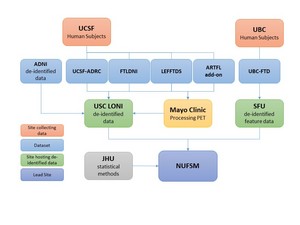You are not logged in. (Sign In)
PREDICT-ADFTD: Multimodal Imaging Prediction of AD/FTD and Differential Diagnosis
PI: Wang (contact), Howie Rosen
Summary:
Accurate diagnosis of frontotemporal dementia (FTD) is difficult because the relationships between clinical syndromes, and pathological and genetic causes are complex. In this project, we propose to use machine learning technologies to develop powerful predictive biomarkers that can distinguish bvFTD, AD and healthy controls, using well-characterized clinical, neurological and neuroanatomical data from multiple national databases. As treatment agents with potential disease-modifying effects are developed, sensitive and specific biomarkers can be tested and then eventually used in the appropriate patient populations.
Papers:
- Development and validation of a novel dementia of Alzheimer's type (DAT) score based on metabolism FDG-PET imaging.
Popuri K, Balachandar R, Alpert K, Lu D, Bhalla M, Mackenzie IR, Hsiung RG, Wang L, Beg MF, Alzheimer's Disease Neuroimaging Initiative
NeuroImage Clinical 2018; 18: 802-13
View Article
Funding:
- NIA: R01 AG055121-01A1 (PREDICT-ADFTD: Multimodal Imaging Prediction of AD/FTD and Differential Diagnosis) (PI: Wang (Contact), Rosen) - We propose to use machine learning technologies to develop predictive biomarkers that can distinguish bvFTD and AD, using well-characterized clinical, neurological and neuroanatomical data from multisite databases. (09/15/2017 - 06/30/2021).
Details:
Alzheimer’s dementia (AD) is the most common form of dementia in adults over the age of 65, and Frontotemporal dementia (FTD) is the leading cause of dementia in middle age, with the behavioral variant subtype (bvFTD) being the most prevalent form. The relationships between clinical syndromes and pathological causes are complex, which makes accurate diagnosis difficult. For example, multiple studies have indicated that a significant proportion of cases of AD-like dementia show evidence of non-AD pathology, such as inclusions of the transactive response DNA-binding protein 43 (TDP-43), a protein associated with clinical FTD. Also, AD neuropathology has been found in 15–30% of patient with the clinical diagnosis of frontotemporal dementia (FTD). As treatment agents with potential disease-modifying effects are developed, sensitive and specific biomarkers will be needed, so that they can be tested and then eventually used in the appropriate patient populations. In this project, we will focus on clinically diagnosed bvFTD and AD patients, and apply machine learning to multimodal neuroimaging (T1, FDG-PET) data pooled from large, multisite studies of AD and FTD. Our goal is to develop novel biomarkers that can differentiate bvFTD, AD and controls. Our hypothesis is that each neuropathology is associated with a distinct biomarker signature, and these signatures can be discovered through well-characterized clinical, neurological and neuroanatomical profiles. We will use available amyloid imaging and cerebrospinal fluid (CSF) measures of β-amyloid and tau to assess the robustness of our predictions of AD neuropathologies. In Aim 1 we will use cross-sectional and longitudinal structural imaging to develop predictive biomarker models for differentiating bvFTD vs. AD. In Aim 2 we will use cross-sectional and longitudinal FDG-PET imaging to develop predictive biomarker models. In Aim 3 we will evaluate the combination of structural and FDG-PET imaging as predictive biomarker models.
Relevance: This research supports NIH initiatives on long-term, personalized precision medicine and big data science. Our predictive biomarker models can inform participant selection in clinical trials so that we can identify disease-modifying treatments with greater power. Our system-biology approach can enable us to generate new questions on mechanisms underlying the origin and progression of neuro-pathological processes, create new data and computational tools that can in turn generate new insights and new hypotheses.
